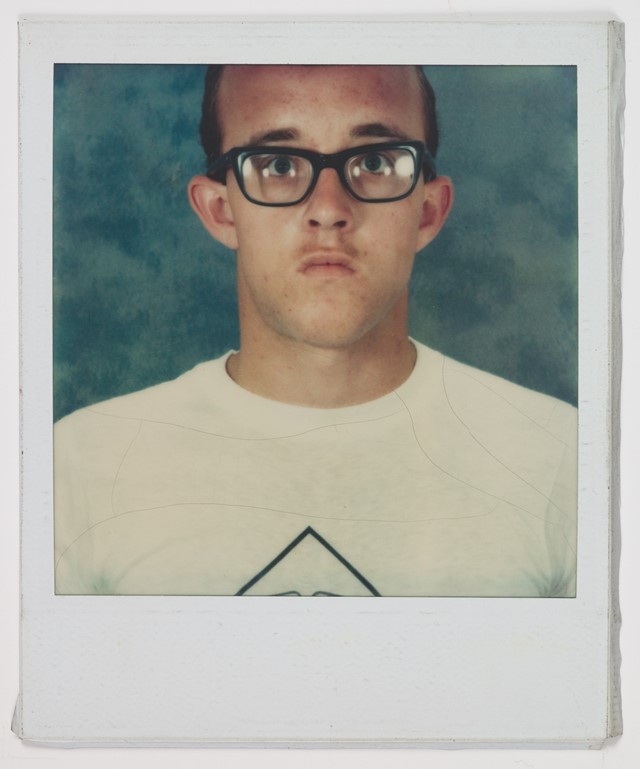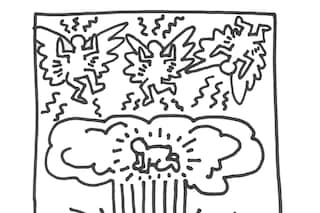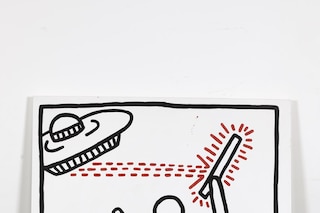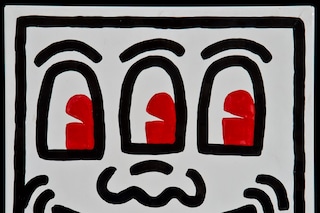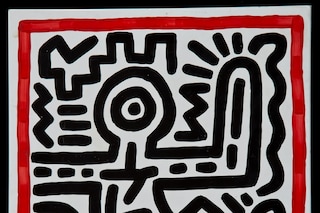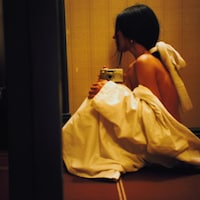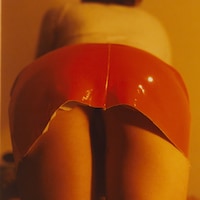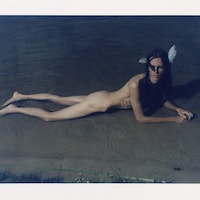We draw on the artist’s own quotes to explore his brief but profound life
By the age of 31, most of us will still be floundering around deciding what we want to be when we grow up, trying to find our calling. Keith Haring was just 31 when he died from Aids-related complications yet, despite the brevity of his life, he left a profound body of work so iconic that it has impressed itself indelibly in the cultural consciousness.
Immediately recognisable for their distinctive and joyful visual language of unique, recurring iconography and motifs, graphic symmetry, vibrating colours, and signature figures moving with kinetic gestural motions, his paintings and designs have been reproduced on clothes, trainers, wall-decals, toys, and posters across the world. He wanted to democratise his art and, in doing so, the imagery he created has become ubiquitous. Like his friend and contemporary, Jean-Michel Basquiat, Keith Haring certainly “coloured every surface with his runes.”
Alongside the legacy of his work, Haring is remembered as a man of great bravery and compassion. Diagnosed as HIV-positive at the height of the Aids-epidemic, he spoke out courageously to dismantle the stigma of fear and ignorance surrounding the virus, while encouraging an open dialogue about the issues facing HIV-sufferers. The Keith Haring Foundation operates to this day, raising money to help young people as well as supporting Aids-related care and education. “He was a person of action and communication; he cared and he made a difference for people, especially children in crisis and in need,” says publisher and art collector Larry Warsh in the introduction to Haring-isms, a new book made in association with No More Rulers, which collects together the artist’s most illuminating quotes and observations.
Below, we take a look at Keith Haring’s life and work through the artists’ own words, as reproduced in Haring-isms.
“Spontaneity is an essential part of everything I make”
There's an almost-childlike spontaneity and naivety about Haring’s work that belies his extraordinary and seemingly instinctual flair for meticulous composition and the complex density of detail in many of his paintings. “I try as much as possible to let the drawings happen by themselves,” Haring famously said. He had an idea, then began drawing. “With certain murals, when he was working at a height and couldn't easily step back, he'd just draw and somehow knew where to put the lines,” Tate Liverpool’s Assistant Curator, Tamar Hemmes, told Dazed. ”It's amazing that he could create such a large image without having to plan it in advance.”
As an avid young viewer of Walt Disney, Looney Tunes, and The Bugs Bunny Show, the childhood influence of cartoons on Haring is impossible to underestimate. It’s one of the most visible and distinctive aspects of his art, not only aesthetically but also in his approach to working and the immediacy of the images he made.
Born in 1958, Haring grew up in Kutztown, Pennsylvania. It was, in his words, “a conservative little town.” Encouraged by his father, an enthusiastic amateur cartoonist, four-year-old Keith began drawing compulsively, as soon as he could hold a pencil. “I picked up on drawing very quickly and I was interested in it, so it became one of the main bonding things (between my dad and I) when I was little.”
The youthful energy of animation and cartoons never left him. “Very rarely is any of the work planned out ahead of time or done in a sort of rational or systematic way to reach a particular goal. It’s almost always a sort of outburst of energy more equivalent to a gesture than planned out, strategic action.” He worked fast. The subway drawings – which had to be made quickly due to the fact he could get caught at any moment – would take him only a few minutes, but his larger paintings on canvas were also made swiftly and energetically. The volume of work he created and the rapidity of its execution is astounding, almost as if he knew his time would be limited.
“One of the reasons I came to New York was to look for my peers.”
In 1978, aged 20, Haring left smalltown Pennsylvania for NYC. “One of the reasons I came to New York was to look for my peers, or find other people that were working with a similar intensity and coming from the same generation,” he said.
Beginning his new life studying painting at the School of Visual Arts by day and working as a busboy at the busy nightclub, Danceteria, by night, Haring thrived amid the febrile atmosphere of the city. 1980s New York was a hotbed of creative energy and the epicentre of contemporary art, from which a host of the most celebrated artists of the twentieth century emerged, and where the likes of Jean-Michel Basquiat, Nan Goldin, Robert Mapplethorpe, Jeff Koons, and Madonna rubbed shoulders with Andy Warhol, Allen Ginsberg, and William Burroughs. “There was the club scene – the Mudd Club and Club 57, at St. Mark’s Place, in the basement of a Polish church, which became our hangout, a clubhouse, where we could do whatever we wanted.”
As a narrator of modern life, his work spoke so much to his time and his contemporaries. He was referencing and responding to the issues of the day, influenced by what was happening around him – popular culture and television (“I probably gained much of my colour sense through luminous colour coming from television”), the urban environment, graffiti, the Aids crisis, anti-nuclear protests, apartheid, drug addiction, the club scene – as well as his peers in NYC at that time.
“As soon as I had this vocabulary of images it almost necessitated that it should be on the street.”
The lexicon of Haring’s recurring icons and symbols – dancing dogs, radiant babies, and signature stick figures – reads like mystical, potent hieroglyphics. “The vocabulary of my images (is) a vocabulary of signs and symbols evoking different ideas, and gaining meaning through repetition, and juxtaposition, changing meaning as they appear over and over ... in different situations,” he explained.
He developed a visual language not only so recognisable but also so eloquent that it embedded itself within the cultural consciousness, achieving a certain universality due to the fluidity and ambiguousness of the characters who populate the world of his paintings. “(My figures) don’t have a race; they don’t have an age; they don’t have a sex. They are more signs for human which in a way is saying that humans are basically all of the same quality and the same importance and that there doesn’t have to be separation. If they have a pregnant stomach, they could be a woman because they have a pregnant stomach, without adding breasts or anything. Which is another thing that made them so instantly universal, like a kind of alphabet.”
Having honed this unique alphabet, he felt compelled to use it to communicate and educate. “As soon as I had this vocabulary of images it almost necessitated that it should be on the street,” he explained. He wanted people to see and engage with his art; Much of his work was a kind of propaganda for compassion but also became part of the language of resistance. Particularly moving is his 1988 “Silence = Death”, painted on an inverted triangular canvas, it features Haring’s signature figures covering their faces and ears in the same manner as the three wise monkeys who “see no evil, hear no evil, speak no evil." Having borrowed the messaging and certain visual elements from ACT UP – a hugely important activist group working to end the epidemic – this image has become synonymous with the fight to end the ignorance and stigma surrounding HIV and Aids.
“Art is for everybody.”
There’s a generosity about Haring’s work, not only in the sentiment and content of his paintings but also in the spirit of his desire to make art democratic.
Posthumously, his artworks have sold for staggering amounts. In 2017, “Untitled” (1982) fetched $6,537,500 at auction at Sotheby’s, New York. Even within his own lifetime, he achieved critical and commercial success at a young age. A CBS news report from 1982 shows scenes of a packed gallery in Soho, full of people clamouring to buy the 24-year-old artist’s work, and reporting (with wry incredulity) that over a quarter of a million dollars worth of paintings were sold within the first few days of the solo show opening. Despite this, he remained steadfastly opposed to the elitism of the art world and often spoke of his disillusionment regarding the necessary evils of dealers and collectors. “The structure of the art “market” was established long before I was involved in it. It is my least favourite aspect of the role of the contemporary artist, however, it cannot be ignored,” he reflected. “The use of galleries and commercial projects has enabled me to reach millions of people whom I would not have reached by remaining an unknown artist. I assumed, after all, that the point of making art was to communicate and contribute to a culture.”
He continued to create unsanctioned public art, in the form of murals and graffiti for which he was still on occasion arrested, even while his work being shown in the city’s illustrious art galleries. “I loved when I had the painting inside the Whitney during the Biennial in 1983 and at the same time I had the exact same images on drawings in the subway, it makes all these contradictions like what is value, what is the difference between a museum and a subway?”
In 1986 he opened Pop Shop, a store in downtown Manhattan selling his designs printed on t-shirts, posters, and various other items. Though he was heavily criticised for commercialisation of his work, he cared more about raising consciousness than he did about raising capital, and his aim was always to make art accessible. “It’s a complete extension of what I was doing on the subway… in that the kind of audience I was reaching in the subway was really spanning all kinds of boundaries of cultural experience and race and education and age and that’s exactly what the store is doing.” Though the shop itself closed in 2005, the online store still sells merchandise and profits go to the Keith Haring Foundation – a charitable organisation dedicated to helping children, alongside Aids-related care, education, and prevention.
“Art is one of the last areas that is totally within the realm of the human individual and can’t be copied or done better by a machine.”
With extraordinary prescience, Haring was extremely conscious about the “delicate balance between ritual and technology.” As a child of ‘the atomic age’, his anxiety about the potential trajecory of technology and its dominance in our everyday lives is a recurring motif of his work. “Untitled” (1984) brings together some of the overarching motifs of his work. In a showdown between humanity/nature and technology, a computer in the centre of the work, positioned on top of a pyramid, dominates the painting with the omnipresence of a deity.
“Art is one of the last areas that is totally within the realm of the human individual and can’t be copied or done better by a machine,” he said, foreshadowing a conversation about the arts that’s even more relevent now – in the age of the automation of everything – than ever before. The practice of art presented itself to Haring, even back then, as a “return to ritual” and a refuge; a space where one couldn’t be made redundant by technological advancements and, therefore, perhaps where genuine human connection lay.
Curator Tamar Hemmes observed, “He would sometimes replace the heads of his figures with a computer screen, which can be interpreted in different ways. But what I think is so interesting is that in 1978, so early on before computers were something that many people were using… Haring was saying we had stopped evolving and technology was taking over – that this technology we had created would take over. That's so interesting when you relate it to the discussion that's going on now about artificial intelligence, where there's this fear about what technology is going to do. The fact that he was having those thoughts 40 years ago is really incredible.”
“If I could clone myself, there would still be too much work to do.”
Despite being a self-confessed workaholic, restlessly trying to fit as much as possible into his time on the planet, Haring graciously accepted the fleeting, finite nature of life. “It wouldn’t matter if you lived until you were 75,” he reasoned, ”There would still be new ideas. There would still be things that you wished you would have accomplished.”
Although interested and conscious of legacy, he also fully embraced the ephemeral within his work and wasn’t afraid of the impermanence of any medium. Alongside habitually decorating the subway with drawings in chalk, he also collaborated with Grace Jones, adorning her famous physique in body paint, as well as creating thousands of flyers to giveaway, and painting murals without permission, knowing they were in danger of being removed or vandalised.
His iconic mural “Crack is Wack” was painted in 1986 on an abandoned handball court visible from New York’s busy FDR Drive. Executed as a warning about the crack-cocaine use that was rife in New York at the time, it was created without official permission from the City. Haring was initially arrested and charged with vandalism but, after pressure from the media, he was released and the mural was put under the protection and jurisdiction of the City Department of Parks where, against all odds and despite occasional vandalism, still exists today.
“There wasn’t much of a distinctive line between (his artworks and his ephemera works),“ says Tamar Hemmes. ”Obviously, they served slightly different purposes, but I think Haring quickly realised that his iconic visual language was quite accessible and a very good way of delivering certain messages and having dialogues with people.”
“Haring-isms” by Keith Haring (edited by Larry Warsh) is published by Princeton University Press in association with No More Rulers
